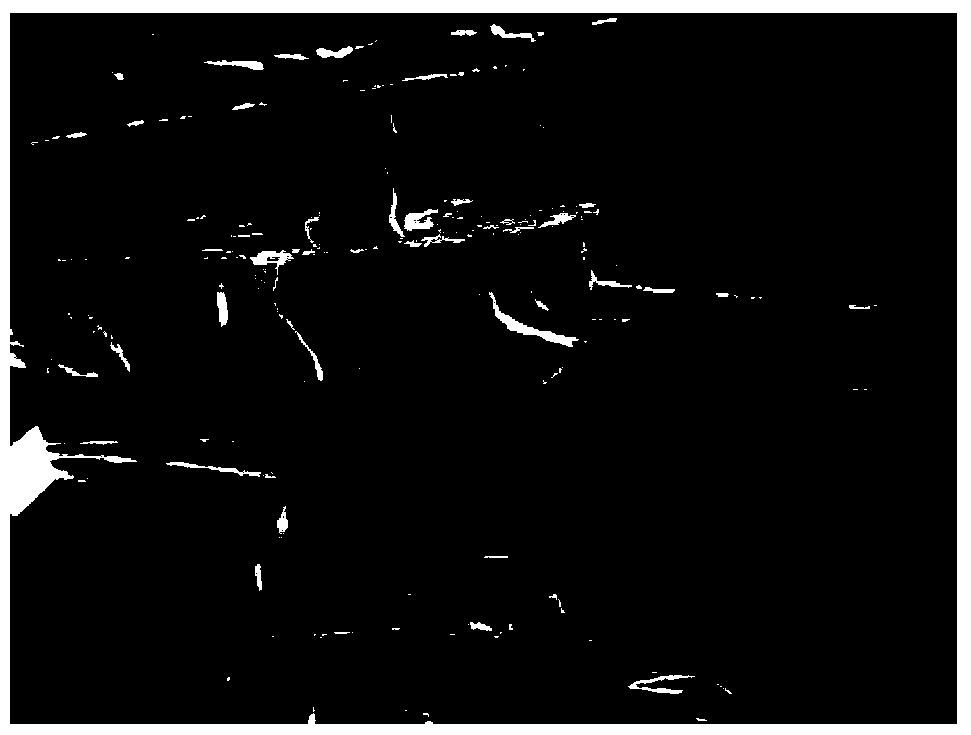Super flat frit dry granular graze fully-polished brick and preparation method thereof
A dry-grain glaze and frit technology, which is applied in the field of ceramic tile production, can solve the problems of poor flatness of the brick surface, restricting the transparent glaze layer, etc., and achieves improved flatness, bright and pure color of the brick surface, and good antifouling effect. Effect
- Summary
- Abstract
- Description
- Claims
- Application Information
AI Technical Summary
Problems solved by technology
Method used
Image
Examples
Embodiment 1
[0050] 1. Press bricks.
[0051] 2. Kiln drying, the drying time is 1h, and the moisture content of the dried billet is controlled within 0.5%.
[0052] 3. Spray the surface glaze, the specific gravity of the surface glaze is 1.40, and the amount of glaze applied is 450g / m 2 ; SiO 2 : 58.2%, Al 2 o 3 : 24.16%, Fe 2 o 3 : 0.31%, TiO 2 : 0.14%, CaO: 0.35%, MgO: 0.18%, K 2 O: 4.44%, Na 2 O: 2.73%, ZrO 2 : 6.12%, loss on ignition: 3.37%.
[0053] 4. Inkjet printing pattern.
[0054] 5. Glue spraying glue for digital machine glue machine (purchased from Siti Berndt Company) glue volume 35-60g / m 2 .
[0055] 6. After digital glue spraying, 2-5s inner cloth frit dry granule glaze, the amount of frit dry granule glaze is 900g / m 2 , the chemical composition of frit dry glaze is: SiO 2 : 57.8%, Al 2 o 3 : 7.93%, CaO: 11.01%, MgO: 0.62%, K 2 O: 6.85%, Na 2 O: 1.94%, ZnO: 11.9%, BaO: 1.61%, loss on ignition: 0.34%. The particle gradation of the fritted dry glaze is as f...
Embodiment 2
[0062] Substantially the same as Example 1, the difference is that the chemical composition of the fritted dry granular glaze is: SiO 2 : 56.81%, Al 2 o 3 : 8.95%, CaO: 11.06%, MgO: 0.57%, K 2 O: 6.55%, Na 2 O: 1.65%, ZnO: 11.81%, BaO: 1.36%, loss on ignition: 0.36%.
[0063] Using the chemical composition of the fritted dry glaze, the quality and effect of the brick surface are compared with Example 1, there is no significant difference, the color of the brick surface is bright and pure, and the thickness of the glaze layer on the brick surface reaches 0.2-0.4mm thick after polishing, and it is transparent It has a strong anti-fouling effect, and the glaze layer has almost no fine bubbles when observed through a magnifying glass, and the antifouling effect is very good. There is no water ripple phenomenon of ordinary glazed tiles, and the flatness is very good.
Embodiment 3
[0065] Basically the same as in Example 1, the difference is that the particle gradation of the fritted dry glaze is: 60 mesh: 50.8%, 60-80 mesh: 32.1%, 80-100 mesh: 10.6%, 100-140 mesh: 3.1%, under 140 mesh: 3.4%.
[0066] Dry granules with the same chemical composition as in Example 1, according to the particle gradation, the dry granules are evenly distributed in the production process, and the quality and effect of the brick surface after firing and polishing are compared with those in Example 1. There is no obvious difference, and the color of the brick surface is bright and pure. , After polishing, the thickness of the glaze layer on the brick surface reaches 0.2-0.4mm thick, and it has a strong sense of transparency. The glaze layer has almost no fine bubbles when observed through a magnifying glass, and the antifouling effect is very good. There is no water ripple phenomenon of ordinary glazed tiles, and the flatness is very good.
PUM
| Property | Measurement | Unit |
|---|---|---|
| thickness | aaaaa | aaaaa |
Abstract
Description
Claims
Application Information
 Login to View More
Login to View More - R&D
- Intellectual Property
- Life Sciences
- Materials
- Tech Scout
- Unparalleled Data Quality
- Higher Quality Content
- 60% Fewer Hallucinations
Browse by: Latest US Patents, China's latest patents, Technical Efficacy Thesaurus, Application Domain, Technology Topic, Popular Technical Reports.
© 2025 PatSnap. All rights reserved.Legal|Privacy policy|Modern Slavery Act Transparency Statement|Sitemap|About US| Contact US: help@patsnap.com

